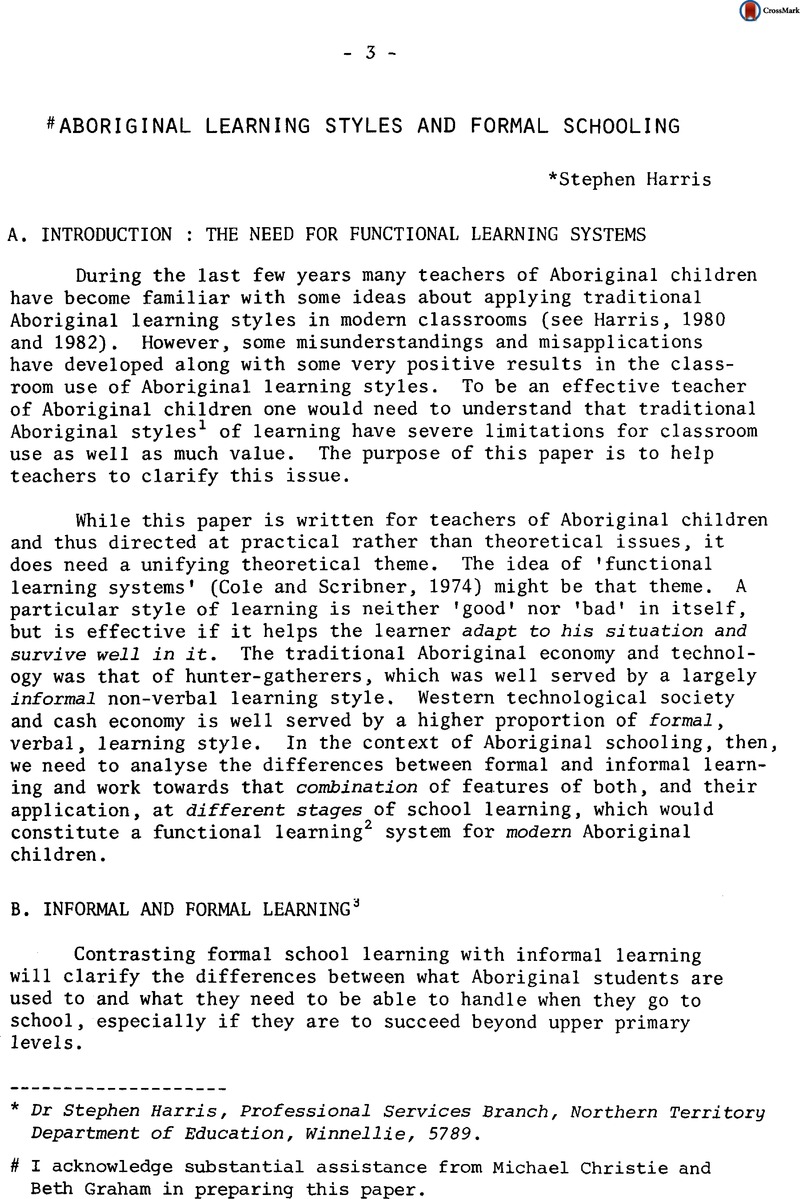Crossref Citations
This article has been cited by the following publications. This list is generated based on data provided by Crossref.
Durre, A.C.
1985.
What to Do Before The Formal Teaching of Reading Begins.
The Aboriginal Child at School,
Vol. 13,
Issue. 1,
p.
18.
Folds, Ralph
1987.
The Social Relationships of Tribal Aboriginal Schooling in Australia.
British Journal of Sociology of Education,
Vol. 8,
Issue. 4,
p.
447.
Ritchie, Steve M.
1987.
Improving the learning environment for Aboriginal students in science classrooms.
Research in Science Education,
Vol. 17,
Issue. 1,
p.
23.
Walsh, Grant
1987.
Aboriginal Primary Education.
The Aboriginal Child at School,
Vol. 15,
Issue. 2,
p.
3.
McGarvie, N.
1988.
The Development of Inservice and Induction Programs for Teachers of Aboriginal and Torres Strait Islander Students in Queensland Schools: an Historical Overview.
The Aboriginal Child at School,
Vol. 16,
Issue. 4,
p.
29.
Dawe, Lloyd
1988.
The Impact of Culture in the Mathematics Classrooms of Multicultural Australia.
Cultural Dynamics,
Vol. 1,
Issue. 2,
p.
195.
Graham, Beth
1988.
Mathematics Education and Culture.
p.
119.
Bell, Helen
1988.
An Overview of Some Aboriginal Teaching and Learning Strategies in Traditionally Oriented Communities.
The Aboriginal Child at School,
Vol. 16,
Issue. 3,
p.
3.
Graham, Beth
1988.
Mathematical education and Aboriginal children.
Educational Studies in Mathematics,
Vol. 19,
Issue. 2,
p.
119.
Folds, Ralph
1989.
A Socio-Cultural Approach to the Bilingual Curriculum in Central Australian Schools.
Curriculum Inquiry,
Vol. 19,
Issue. 1,
p.
33.
Ninnes, P. M.
1994.
Toward a functional learning system for Solomon Island secondary science classrooms.
International Journal of Science Education,
Vol. 16,
Issue. 6,
p.
677.
Turner, Christine
1997.
The Injinoo Home Language Program: A Positive Community Response to Marginalisation and Institutional Racism.
The Australian Journal of Indigenous Education,
Vol. 25,
Issue. 1,
p.
1.
Barnes, A.L.
2000.
Learning Preferences of Some Aboriginal and Torres Strait Islander Students in the Veterinary Program.
The Australian Journal of Indigenous Education,
Vol. 28,
Issue. 1,
p.
8.
Boulton-Lewis, Gillian M
Marton, Ference
Lewis, David C
and
Wilss, Lynn A
2000.
Learning in formal and informal contexts: conceptions and strategies of Aboriginal and Torres Strait Islander university students.
Learning and Instruction,
Vol. 10,
Issue. 5,
p.
393.
Martin, Andrew J.
2006.
A Motivational Psychology for the Education of Indigenous Australian Students.
The Australian Journal of Indigenous Education,
Vol. 35,
Issue. 1,
p.
30.
Cairney, Trevor H.
2008.
Encyclopedia of Language and Education.
p.
615.
Kostogriz, Alex
and
Doecke, Brenton
2008.
English and its Others: Towards an Ethics of Transculturation.
Changing English,
Vol. 15,
Issue. 3,
p.
259.
Kral, Inge
and
Heath, Shirley Brice
2013.
The world with us: Sight and sound in the “cultural flows” of informal learning. An Indigenous Australian case.
Learning, Culture and Social Interaction,
Vol. 2,
Issue. 4,
p.
227.
Cairney, Trevor H.
2016.
Literacies and Language Education.
p.
1.
Martin, Gregory
Nakata, Vicky
Nakata, Martin
and
Day, Andrew
2017.
Promoting the persistence of Indigenous students through teaching at the Cultural Interface.
Studies in Higher Education,
Vol. 42,
Issue. 7,
p.
1158.



